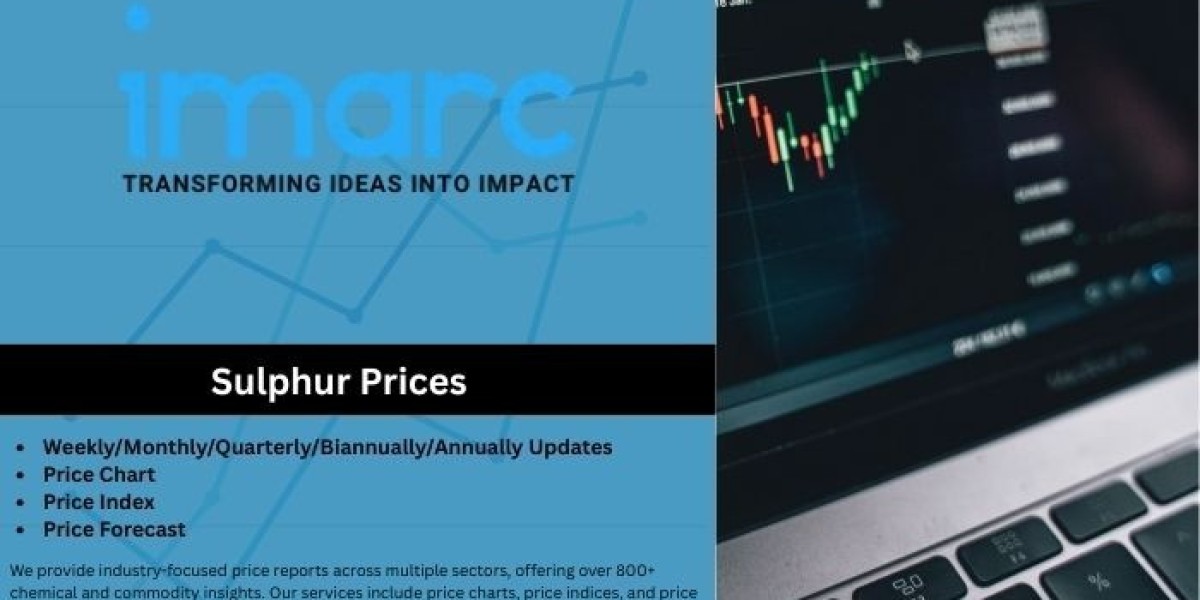North America Sulphur Prices Movement Q1 2025:
Sulphur Prices in the United States:
Product | Category | Price |
Sulphur | Bulk Chemical & Fertilizer | 140 USD/MT |
During the first quarter of 2025, sulphur prices in the USA remained stable, reaching around 140 USD/MT in March. This stability was largely driven by a balanced supply and demand scenario, with smooth refinery operations across key regions like the Gulf Coast. Despite minor transportation disruptions due to cold weather, market conditions were steady. According to Sulphur Price Forecast Data, the equilibrium between production and consumption helped maintain consistent pricing throughout the quarter.
Get the Real-Time Prices Analysis: https://www.imarcgroup.com/sulphur-pricing-report/requestsample
Note: This analysis can be adjusted to align with the customer's individual preferences
APAC Sulphur Prices Movement Q1 2025:
Sulphur Prices in China:
Product | Category | Price |
Sulphur | Bulk Chemical & Fertilizer | 290 USD/MT |
In the first quarter of 2025, sulphur prices in China rose sharply, reaching 290 USD/MT by March. This increase was mainly driven by strong post-Lunar New Year demand from agrochemical manufacturers. At the same time, supply remained limited due to production slowdowns and distribution challenges in central and eastern regions. According to the Price Trend of Sulphur, these combined factors significantly contributed to the upward momentum in the Chinese sulphur market.
Regional Analysis: The price analysis can be extended to provide detailed Sulphur price information for the following list of countries.
China, India, Indonesia, Pakistan, Bangladesh, Japan, Philippines, Vietnam, Thailand, South Korea, Malaysia, Nepal, Taiwan, Sri Lanka, Hong Kong, Singapore, Australia, and New Zealand, among other Asian countries.
European Sulphur Prices Movement Q1 2025:
Sulphur Prices in Europe:
Product | Category | Price |
Sulphur | Bulk Chemical & Fertilizer | 195 USD/MT |
In the first quarter of 2025, sulphur prices in Europe rose to 195 USD/MT by March, largely due to limited supply caused by refinery issues such as planned maintenance and unexpected fires. While demand from the agricultural sector remained steady, it did not increase significantly. According to Sulphur Price Forecast Data, this imbalance between constrained supply and stable demand led to sustained high prices across the European market during the period.
Regional Analysis: The price analysis can be expanded to include detailed Sulphur price data for a wide range of European countries:
such as Germany, France, the United Kingdom, Italy, Spain, Russia, Turkey, the Netherlands, Poland, Sweden, Belgium, Austria, Ireland, Switzerland, Norway, Denmark, Romania, Finland, the Czech Republic, Portugal, and Greece, along with other European nations.
MEA Sulphur Prices Movement Q1 2025:
Sulphur Prices in United Arab Emirates:
Product | Category | Price |
Sulphur | Bulk Chemical & Fertilizer | 174 USD/MT |
During Q1 2025, sulphur prices in the UAE reached 174 USD/MT, primarily influenced by fluctuations in the petroleum sector, which affected production costs due to sulphur being a by-product of oil refining. Despite these supply-side changes, steady demand from fertilizer manufacturers helped maintain market stability. As per Price Trend of Sulphur Data, the market reflected a balanced trend, driven by consistent consumption and variable production conditions throughout the quarter.
Regional Analysis: The price analysis can be extended to provide detailed Sulphur price information for the following list of countries.
Saudi Arabia, UAE, Israel, Iran, South Africa, Nigeria, Oman, Kuwait, Qatar, Iraq, Egypt, Algeria, and Morocco, among other Middle Eastern and African countries.
Key Factors Influencing Sulphur Price Trend, Index, and Forecast (2025)
Global Supply and Refinery Output
Sulphur is mainly produced as a byproduct of oil and gas refining. Changes in refinery activity, especially in major producing regions like the Middle East and China, directly impact sulphur supply and price volatility. Any reduction in oil refining or disruptions at refineries can quickly tighten supply and push prices higher.
Geopolitical and Trade Disruptions
Political tensions, sanctions, export restrictions, and environmental policies in key countries can disrupt global sulphur supply chains. Trade barriers and new regulations, such as those in the EU, add uncertainty and can cause price spikes or regional price differences.
Demand from Agriculture and Industry
The agriculture sector, especially phosphate fertilizer production, is a major consumer of sulphur. Growing demand in emerging markets like India, Brazil, and Africa supports higher prices. Steady or rising demand from agrochemicals and industrial users keeps the market firm, especially during planting seasons.
Regional Market Dynamics and Logistics
Sulphur prices vary widely by region due to differences in local production, proximity to supply hubs, transportation costs, and logistical challenges. For example, supply constraints in China and Europe, or high import reliance in regions like Singapore, can lead to significant price variations.
Inventory Levels and Seasonal Patterns
Tight inventories and seasonal demand surges, such as after the Chinese New Year or during planting seasons, often lead to short-term price increases. Conversely, high stock levels or weak demand can put downward pressure on prices.
Production and Operational Costs
Fluctuations in oil prices and refinery operating costs influence sulphur production expenses. Maintenance shutdowns, unplanned outages, or natural disasters can reduce output and cause supply shortages, supporting higher prices.
Sulphur Price Outlook and Forecast for 2025
- Asia: Prices are expected to remain bullish due to strong demand from fertilizers and ongoing supply constraints, especially in China.
- Europe: The market is likely to stay tight with high prices, driven by refinery maintenance and limited imports.
- North America: Stable supply from refineries and steady agricultural demand should keep prices firm, though weather or logistical disruptions may cause short-term volatility.
Summary:
Sulphur prices in 2025 are shaped by refinery output, geopolitical events, agricultural demand, regional logistics, inventory levels, and production costs. The overall trend points to firm or rising prices in most regions, especially where supply constraints and strong demand persist.
FAQs based on Sulphur Price Trend, Index, and Forecast:
What is driving the current sulphur price trend globally in 2025?
The sulphur price trend in 2025 is largely influenced by regional supply constraints, refinery maintenance schedules, and strong demand from the agrochemical sector. In Asia, post-holiday industrial ramp-ups and logistical issues are pushing prices higher, while in Europe, unplanned refinery outages have led to reduced availability. The Middle East and North America, however, show more stability due to steady production and balanced demand.
How is the sulphur price index calculated, and what does it indicate?
The sulphur price index is calculated based on average regional spot prices, factoring in market transactions, supply-demand balance, and freight costs. It serves as a benchmark to track market performance over time and helps buyers, traders, and manufacturers understand price direction and volatility across global markets.
What is the sulphur price forecast for the coming months?
The sulphur price forecast indicates a likely increase in prices across Asian and European markets due to ongoing supply bottlenecks and rising demand in fertilizer production. In contrast, prices in North America and the Middle East are expected to remain relatively stable, barring any major refinery disruptions or shifts in the oil industry, which impact sulphur recovery.
Why are sulphur prices higher in Asia compared to other regions?
Sulphur prices in Asia are higher due to a combination of post-holiday industrial demand, especially from agrochemical producers, and limited supply caused by operational delays and logistics congestion. Additionally, reduced imports and tighter domestic inventories have contributed to bullish market sentiment and price surges, particularly in China and Southeast Asia.
How do fluctuations in crude oil prices affect sulphur prices?
Sulphur is often recovered as a byproduct of petroleum refining and natural gas processing. When crude oil production or refining activities fluctuate, due to geopolitical tensions, OPEC decisions, or refinery maintenance, sulphur output is directly impacted. This linkage means that any volatility in crude oil markets can cause corresponding changes in sulphur availability and prices.
Key Coverage:
- Market Analysis
- Market Breakup by Region
- Demand Supply Analysis by Type
- Demand Supply Analysis by Application
- Demand Supply Analysis of Raw Materials
- Price Analysis
- Spot Prices by Major Ports
- Price Breakup
- Price Trends by Region
- Factors Influencing Price Trends
- Market Drivers, Restraints, and Opportunities
- Competitive Landscape
- Recent Developments
- Global Event Analysis
How IMARC Pricing Database Can Help
The latest IMARC Group study, “Sulphur Prices, Trend, Chart, Demand, Market Analysis, News, Historical and Forecast Data 2025 Edition,” presents a detailed analysis of the Sulphur price trend, offering key insights into global Sulphur market dynamics. This report includes comprehensive price charts, which trace historical data and highlight major shifts in the market.
The analysis delves into the factors driving these trends, including raw material costs, production fluctuations, and geopolitical influences. Moreover, the report examines Sulphur demand, illustrating how consumer behaviour and industrial needs affect overall market dynamics. By exploring the intricate relationship between supply and demand, the prices report uncovers critical factors influencing current and future prices.
About Us:
IMARC Group is a global management consulting firm that provides a comprehensive suite of services to support market entry and expansion efforts. The company offers detailed market assessments, feasibility studies, regulatory approvals and licensing support, and pricing analysis, including spot pricing and regional price trends. Its expertise spans demand-supply analysis alongside regional insights covering Asia-Pacific, Europe, North America, Latin America, and the Middle East and Africa. IMARC also specializes in competitive landscape evaluations, profiling key market players, and conducting research into market drivers, restraints, and opportunities. IMARC’s data-driven approach helps businesses navigate complex markets with precision and confidence.
Contact us:
IMARC Group
134 N 4th St. Brooklyn, NY 11249, USA
Email: sales@imarcgroup.com
Tel No: (D) +91 120 433 0800
United States: +1-631-791-1145








